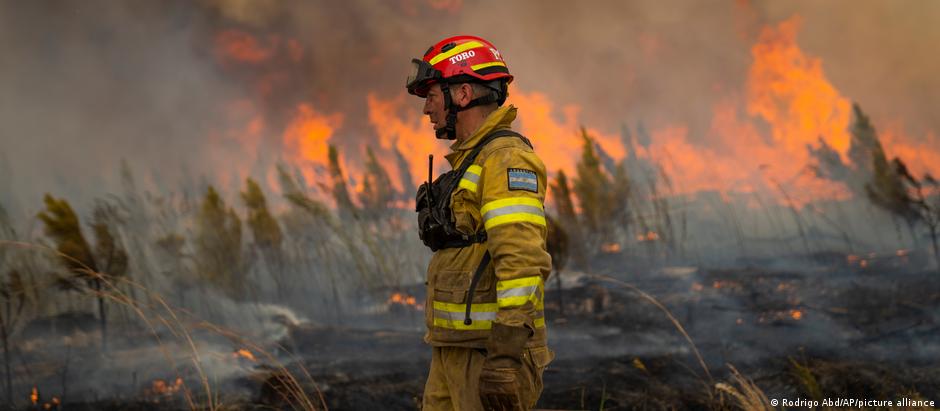
 The report predicts that outbreaks will become more frequent and extreme in green areas, even in unusual places like the Arctic. Experts urge governments to invest more in prevention, not just in fighting fires. Weary firefighters have been battling fires in northern Argentina for weeks. Due to low moisture from strong winds, low rainfall and an exceptionally long drought, wildfires have destroyed nearly 8,000 square kilometers of forest, swamps and farmland – an area equivalent to the five cities of So Paulo. “It’s never happened to us, we’ve never experienced anything like this, we were really beaten up,” resident George Ayala told the AP news agency over the weekend. And the hope is that such disasters will become more stable and devastating in the years and decades to come. According to a new report from the United Nations Environment Program, extreme fires – more frequent, intense and increasingly localized in unusual regions such as the Arctic – are expected to increase by 14% by 2030 and 30% by mid-century. (UNEP) and the non-profit Environment Center GRID-Arendal, Norway. The report says that by 2100 the probability of a fire could increase to 50%. Even if the world reduces emissions significantly, there will still be an increase in wildfires. Researchers have linked these disasters to human-caused climate change, a fact highlighted by the report, which links the increased severity of fires to greater incidence of drought, rising temperatures and strong winds. “At the same time, climate change is exacerbated by wildfires, primarily through the destruction of sensitive, carbon-rich ecosystems such as peatlands and rainforests,” say the report’s authors. As these ecosystems are destroyed, they release already contained CO2 loads into the atmosphere, contributing to further global warming and reducing their ability to capture future emissions. “It turns the landscape into a powder keg, making it harder to stop rising temperatures.” Poor Nation Most Affected The terrifying prophecy is already beginning to come true. In recent years, places such as North America, Brazil, parts of Europe, Siberia and Australia have experienced increasingly destructive fire seasons that have devastated ecosystems and communities around the world. This destruction – of crops and homes, human health and nature – shows that wildfires “disproportionately affect the world’s poorest countries”, according to the report. The consequences can last for years after a fire is put out, especially in parts of the world where resources are lacking to rebuild and adapt to a changing environment. “Fire affects air, soil, water,” recalls Glynis Humphrey of the University of Cape Town, who contributed to the report. “Fire interacts closely with climate in terms of carbon emissions and precipitation patterns, and affects the health of humans and ecosystems. And it affects jobs and the economic situation in which individuals find themselves.” focus on prevention, not response it happens. To address this growing risk and mitigate the effects of catastrophic fires, governments will need to “fundamentally change their investments.” “The current government’s responses to wildfires often put money in the wrong place,” says UNEP executive director Inger Andersen. “We need to reduce the risks of extreme wildfires by being better prepared: investing more in reducing fire risk, working with local communities, and strengthening global commitment to fighting climate change.” The report asked governments to allocate two-thirds of the funds to planning, prevention, preparedness and recovery. “It is imperative that fires do the same thing as flood and drought disaster management,” Humphrey told a news conference. “It’s absolutely necessary.” Indigenous knowledge While some of this funding should go towards better monitoring and analysis to better understand how wildfires are evolving in the changing climate, and what can be done to manage it, The author also highlights the importance of indigenous knowledge. This may involve induced burning, or using a “good fire” to reduce fuel capable of stoking large flames. Other methods include creating firebreaks or setting up a mosaic landscape using controlled flames, which prevent the spread of wildfires; Or promote the growth of grasses and plants that help prevent drought. Peter Moore, who works as a fire management specialist at the Food and Agriculture Organization, says, “As countries and economies develop, and demographics change, many of these traditional practices lose strength or change over time. are or diminish, or give way to alternative practices.” United Nations (FAO). Responding to a DW investigation, Moore pointed out that indigenous practices are being recognized and implemented in Australia, Canada and the western United States, with organizations such as the International Savannah Fire Management Initiative adopting traditional Indigenous practices from Australia. has been transplanted to places like Botswana. .. The former FAO expert emphasized that documentation and having this knowledge widely accessible is the key to convincing the world of the value of these traditional practices, “Being able to map experience [indígena]To work with it and put it back into the environment.” Author: Martin Kuebler
The report predicts that outbreaks will become more frequent and extreme in green areas, even in unusual places like the Arctic. Experts urge governments to invest more in prevention, not just in fighting fires. Weary firefighters have been battling fires in northern Argentina for weeks. Due to low moisture from strong winds, low rainfall and an exceptionally long drought, wildfires have destroyed nearly 8,000 square kilometers of forest, swamps and farmland – an area equivalent to the five cities of So Paulo. “It’s never happened to us, we’ve never experienced anything like this, we were really beaten up,” resident George Ayala told the AP news agency over the weekend. And the hope is that such disasters will become more stable and devastating in the years and decades to come. According to a new report from the United Nations Environment Program, extreme fires – more frequent, intense and increasingly localized in unusual regions such as the Arctic – are expected to increase by 14% by 2030 and 30% by mid-century. (UNEP) and the non-profit Environment Center GRID-Arendal, Norway. The report says that by 2100 the probability of a fire could increase to 50%. Even if the world reduces emissions significantly, there will still be an increase in wildfires. Researchers have linked these disasters to human-caused climate change, a fact highlighted by the report, which links the increased severity of fires to greater incidence of drought, rising temperatures and strong winds. “At the same time, climate change is exacerbated by wildfires, primarily through the destruction of sensitive, carbon-rich ecosystems such as peatlands and rainforests,” say the report’s authors. As these ecosystems are destroyed, they release already contained CO2 loads into the atmosphere, contributing to further global warming and reducing their ability to capture future emissions. “It turns the landscape into a powder keg, making it harder to stop rising temperatures.” Poor Nation Most Affected The terrifying prophecy is already beginning to come true. In recent years, places such as North America, Brazil, parts of Europe, Siberia and Australia have experienced increasingly destructive fire seasons that have devastated ecosystems and communities around the world. This destruction – of crops and homes, human health and nature – shows that wildfires “disproportionately affect the world’s poorest countries”, according to the report. The consequences can last for years after a fire is put out, especially in parts of the world where resources are lacking to rebuild and adapt to a changing environment. “Fire affects air, soil, water,” recalls Glynis Humphrey of the University of Cape Town, who contributed to the report. “Fire interacts closely with climate in terms of carbon emissions and precipitation patterns, and affects the health of humans and ecosystems. And it affects jobs and the economic situation in which individuals find themselves.” focus on prevention, not response it happens. To address this growing risk and mitigate the effects of catastrophic fires, governments will need to “fundamentally change their investments.” “The current government’s responses to wildfires often put money in the wrong place,” says UNEP executive director Inger Andersen. “We need to reduce the risks of extreme wildfires by being better prepared: investing more in reducing fire risk, working with local communities, and strengthening global commitment to fighting climate change.” The report asked governments to allocate two-thirds of the funds to planning, prevention, preparedness and recovery. “It is imperative that fires do the same thing as flood and drought disaster management,” Humphrey told a news conference. “It’s absolutely necessary.” Indigenous knowledge While some of this funding should go towards better monitoring and analysis to better understand how wildfires are evolving in the changing climate, and what can be done to manage it, The author also highlights the importance of indigenous knowledge. This may involve induced burning, or using a “good fire” to reduce fuel capable of stoking large flames. Other methods include creating firebreaks or setting up a mosaic landscape using controlled flames, which prevent the spread of wildfires; Or promote the growth of grasses and plants that help prevent drought. Peter Moore, who works as a fire management specialist at the Food and Agriculture Organization, says, “As countries and economies develop, and demographics change, many of these traditional practices lose strength or change over time. are or diminish, or give way to alternative practices.” United Nations (FAO). Responding to a DW investigation, Moore pointed out that indigenous practices are being recognized and implemented in Australia, Canada and the western United States, with organizations such as the International Savannah Fire Management Initiative adopting traditional Indigenous practices from Australia. has been transplanted to places like Botswana. .. The former FAO expert emphasized that documentation and having this knowledge widely accessible is the key to convincing the world of the value of these traditional practices, “Being able to map experience [indígena]To work with it and put it back into the environment.” Author: Martin Kuebler![]()
Questions, criticisms and suggestions? talk to us



